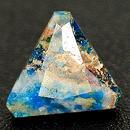|
|
||||||||||||||||
|
||||||||||||||||
|
||||||
|
|
|
|
Diaboleite
|
|
| | |
| Discovered in 1923; IMA status: Valid (pre-IMA; Grandfathered) | ||
|
| ||
|
Chemistry |
|
|
| |
|
Pb2CuCl2(OH)4 | |
|
|
Lead Copper Chloride Hydroxide |
|
Molecular Weight: |
616.88 gm |
|
Composition: |
Copper |
10.30 % |
Cu |
11.60 % |
Cu2O |
|
|
Hydrogen |
0.65 % |
H |
5.84 % |
H2O |
|
|
Lead |
67.18 % |
Pb |
72.36 % |
PbO |
|
|
Chlorine |
11.49 % |
Cl |
11.49 % |
Cl |
|
|
— |
- % |
Cl |
-2.59 % |
-O=Cl2 |
|
|
Oxygen |
10.37 % |
O |
|
|
|
|
|
100.00 % |
|
98.70 % |
= TOTAL OXIDE |
|
|
|
||||
|
Classification |
|
|
| |
|
HALIDES | |
|
3/D.12-50 | |
|
|
3 : HALIDES
|
|
Related to: |
n/a |
|
Varieties: |
None |
|
Synonyms: |
None |
|
|
|
|
Crystal Data |
|
|
|
|
|
Crystals tabular on {001}, exhibiting square or octagonal outline with vicinal forms, rarely showing pyramidal hemihedralism, to 2 em; in subparallel aggregates; massive. |
|
|
None |
|
|
|
|
|
Physical Properties |
|
|
|
|
|
Perfect on {001} |
|
|
Conchoidal |
|
|
Brittle |
|
|
2.5 |
|
|
5.41 - 5.43 (g/cm3) |
|
|
None |
|
|
Not Radioactive |
|
|
Other: |
Completely soluble in nitric acid. |
|
|
|
|
Optical Properties |
|
|
|
|
|
Deep blue; pale blue in transmitted light |
|
|
Transparent to Translucent |
|
|
Adamantine, pearly on cleavages |
|
|
1.850 - 1.980 Uniaxial ( - ) |
|
|
0.130 |
|
|
n/a |
|
|
None |
|
|
|
|
|
Occurances |
|
|
|
|
|
Geological Setting: |
In oxidized manganese ores (Mendip Hills, England); a secondary mineral in deeply oxidized Pb-Cu ores (Tiger, Arizona, USA); in slag exposed to seawater. |
|
Common Associations: |
Chloroxiphite, Hydrocerussite, Mendipite, Cerussite (Mendip Hills, England); Boleite, Wherryite, Hydrocerussite, Leadhillite, Phosgenite, Caledonite, Atacamite, Paratacamite, Cerussite (Tiger, Arizona, USA). |
|
Common Impurities: |
n/a |
|
Type Locality: |
Higher Pitts Mine, Priddy, Mendip Hills, Somerset, England, UK |
|
Year Discovered: |
1923 |
|
View mineral photos: | |
|
|
|
|
More Information |
|
|
|
|
|
| |
|
|
|
|
Locations
for Diaboleite: In England, at the Higher Pitts Farm,
Mendip Hills, and the Merehead quarry, near Shepton
Mallet, Somerset; at Padstow Consols, Padstow, Cornwall.
In Germany, from the Christian-Levin mine, near Essen,
North Rhine-Westphalia, and from Richelsdorf, Hesse,
in slag. Along Baratti Beach, Tuscany, Italy, in slag.
At Laurium, Greece, in slag. In the USA, exceptional
crystals from the Mammoth-St. Anthony mine, Tiger, Pinal
County, and from the Rowley mine, Maricopa County, Arizona.
In Iran, in the Tchah Khuni and other mines in the Anarak
district; the Seh-Changi mine, near Neyband, Khorassan;
and at Abdol Abad, Tabas. From Moolyella, and at the
Anticline prospect, 11 km west-southwest of Ashburton
Downs homestead, Capricorn Range, Western Australia.
In the Santa Ana mine, Caracoles, Sierra Gorda district,
Chile. Found at an undefined locality in the Kopet-
Dag Range, Cheleken Peninsula, Russia. |
|
|
We
have not photographed our Diaboleite gems yet. Please
check back soon. |
